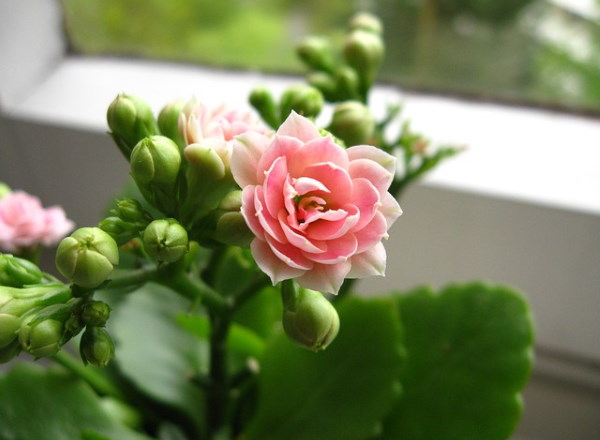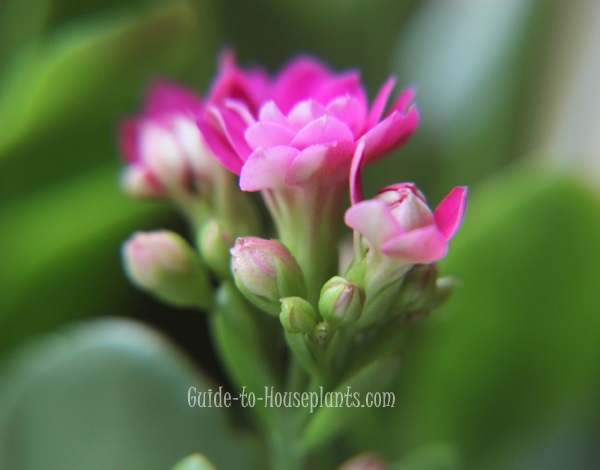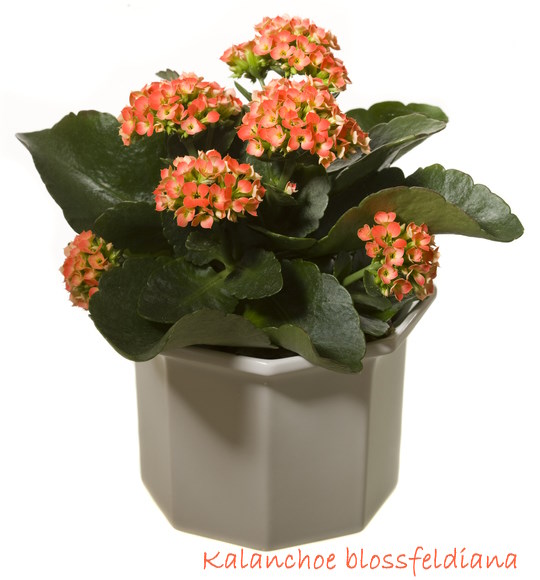Kalanchoe blossfeldiana Indoor Plant Care
Botanical Name: Kalanchoe blossfeldiana
Flaming Katy is one of the few succulents grown just for its blooms. Bright clusters of tiny red, orange, yellow, white, purple or pink flowers last several weeks. Flowers may be single or double.
 Give Kalanchoe plant lots of sunshine to make it bloom. Image by Tinix
Give Kalanchoe plant lots of sunshine to make it bloom. Image by TinixKalanchoe plant has glossy, green leaves with scalloped edges that can become red-tinged when exposed to full sun. Although the thick leaves seem sturdy, they are actually quite brittle. Handle flaming katy with care because the leaf tips easily break off.
When you’re buying a Kalanchoe plant, choose one with bright, fresh-looking leaves and plenty of unopened buds — sure signs of a healthy plant.
Kalanchoe care is easy — providing you can give Kalanchoe blossfeldiana plenty of sunlight and the right amount of water. Resist the temptation to overwater Kalanchoe. Like other succulent plants, it stores water in its thick, fleshy leaves and can suffer from root rot if it is overwatered.
Caring for Kalanchoe Plant – Problems and Solutions
Deadhead spent blooms. You’ll get the most flowers by deadheading during the flowering season. Cut off flower stems after the blooms have faded to encourage more blooms. Cut them at the base of the plant to keep the plant looking its best.
Wondering whether to repot…or not? It’s not necessary. Never repot a plant while it’s blooming because it stresses the plant and may cause its flowers and flower buds to fall off. If you want to cover up a plain nursery pot, just slip it into a cachepot — a decorative pot without drainage holes. It’s a good idea to put small rocks in the bottom of the cachepot to keep the inner pot above drainage water.
Wilted leaves? You overwatered. If you’ve been watering regularly and the leaves are soft and limp, the plant is likely suffering from root rot. Slip the plant out of the pot and take a peek at its roots. Are they soft and mushy? If so, you can toss out the plant — it likely won’t recover. If flaming katy is wilting for no apparent reason, it may be infested with root mealybugs. (See “Something bugging your plant?” below).
Yellow, wrinkled leaves are caused by dry soil. Cut off any affected leaves. Water thoroughly to ensure all roots are moistened, then empty drainage tray.
Something bugging your plant? Few pests bother flaming katy. Mealybugs are the most common invaders. Watch for white, fuzzy patches near the leaf axils and under the leaves. Root mealybugs could be the cause of a wilted plant. Ease the plant out of its pot and inspect the roots for these pests. Treat any infestation as soon as you see them to prevent pests from invading your other indoor plants. If it’s badly infested, get rid of it. It’s easier to replace your plant.
 Flower Power! Hybrids can produce several clusters of up to 50 small, long-lasting flowers.
Flower Power! Hybrids can produce several clusters of up to 50 small, long-lasting flowers.Although this compact, little house plant is easy to grow, getting it to re-bloom can be a challenge.
How to Get Kalanchoe Plant to Bloom Again
- Long, sunny days followed by shorter hours of daylight are needed to set flower buds.
- If you move the plant outside for the summer, keep it in the shade. Morning sun is fine.
- Beginning in early October, keep the plant in a dark room for 14 hours each night for 2 weeks, and give it moderate light during the day.
- Water it minimally and don’t fertilize during this time. Shriveled, yellow leaves are a sign that it’s too dry.
- Flower buds will appear in about 6-8 weeks. Then you can resume with normal care. Flowering may be erratic, but the foliage will still be attractive.
Flaming Katy Plant Care Tips

Origin: Madagascar
Height: 8-15 inches (20-38 cm)
Light: Bright light to full sun.
Water: Keep the soil mix barely moist. Take care not to overwater Kalanchoe, which will cause leaves to wilt and may lead to root rot. Use a pot with drainage holes; water thoroughly, then allow the top 1 inch (2.5 cm) of soil to dry out before watering. Don’t allow the soil to dry out completely, however. Dry soil will cause the leaves to shrivel and turn yellow. Water sparingly after it stops flowering.
Humidity: Average room (around 40-50% relative humidity).
Temperature: Average room temperatures 65-80°F/18-27°C
Soil: 2 parts all-purpose potting mix and 1 part horticultural sand or perlite.
Fertilizer: Feed monthly from late spring to early fall with balanced water-soluble fertilizer.
Propagation: Take stem cuttings in late spring.




